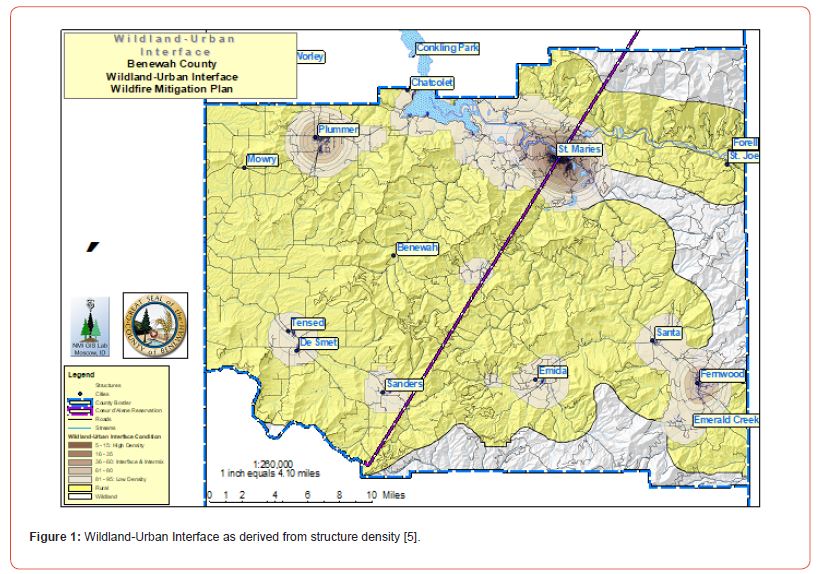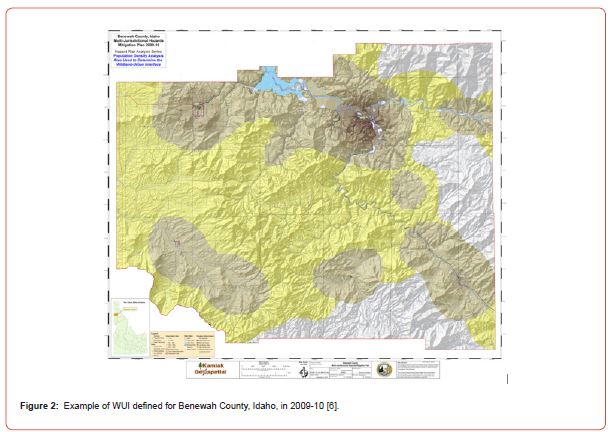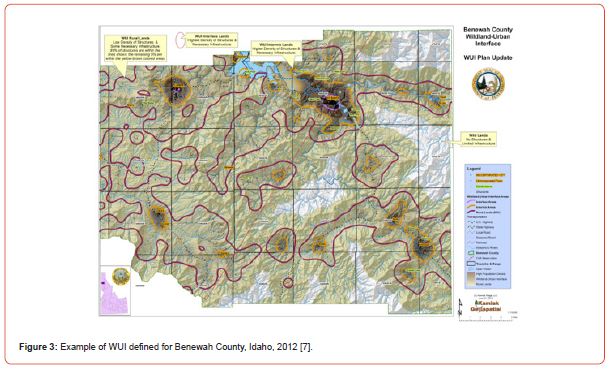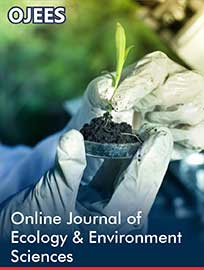 Research Article
Research Article
Defining the Wildland Urban Interface: A Logic Graphical Interpretation of Population Density
William E Schlosser*
Environmental Scientist & Regional Planner, D&D Larix, LLC, USA
William E. Schlosser, Environmental Scientist & Regional Planner, D&D Larix, LLC, USA. Email: Schlosser@Resource-Analysis.com
Received Date: July 18, 2023; Published Date: July 26, 2023
Abstract
The Wildland-Urban Interface (WUI) represents the intermix of human settlements and Fire-Prone Landscapes (FPL), posing significant risks from extreme wildfires. This article presents a logic-graphical interpretation of the WUI, focusing on population density derived from structure locations. Accurate mapping of the WUI is crucial for effective wildfire management. Additionally, FPL analysis, which identifies areas with high wildfire risks, complements the WUI assessment. Separating these two analyses allows for a comprehensive understanding of wildfire threats.
The proposed methodology utilizes Geographical Information System (GIS) techniques to visualize the interaction between fire-prone landscapes and human settlements, enabling the identification of high-risk areas. The integration of the WUI definition and comprehensive risk assessment guides the development of Wildfire Mitigation Plans, ensuring the safety and continuity of communities. Collaboration between federal agencies, Tribal and County governments, as guided by the Healthy Forests Restoration Act (HFRA), promotes a comprehensive approach to wildfire management in the WUI. This article contributes to the understanding and management of the WUI, emphasizing the importance of accurate delineation, risk assessment, and collaboration in safeguarding lives and minimizing the socioeconomic impact of wildfires.
Keywords:Wildland Urban Interface; GIS mapping; Population density; Wildfire mitigation; Community safety; Critical infrastructure; Integrated approaches; Fire Prone landscapes
Abbreviations:FEMA: Federal Emergency Management Agency; FPL: Fire-Prone Landscapes; GIS: Geographical Information System; HFRA: Healthy Forests Restoration Act; IIC: Interface Interagency Committees; NAIP: National Agriculture Inventory Program; PVC: Percent Volume Content; WUI: Wildland-Urban Interface
Introduction
The Wildland-Urban Interface (WUI) represents the dynamic interface between human settlements and Fire-Prone Landscapes (FPL), where the risk of extreme wildfires threatens lives, structures, economies, and the overall way of life [1]. This article provides a logic-graphical interpretation of the WUI, focusing on population density as a fundamental criterion derived from the location of structures. Accurately defining and mapping the WUI is essential for effective wildfire management and community safety. By under standing the boundaries of the WUI and assessing the risks associated with this interface, communities can develop comprehensive Wildfire Mitigation Plans to ensure the safety and continuity of their lives.
The concept of the WUI gained significant attention with the introduction of the Healthy Forests Restoration Act (HFRA) [2]. This legislation, signed into law by President George W. Bush, aimed to reduce the threat of destructive wildfires while upholding environmental standards and fostering early public input during review and planning processes. This concept was adopted and carried forward by the Federal Emergency Management Agency (FEMA) in Multi-Jurisdictional Hazard Mitigation Plans. The HFRA and FEMA both emphasized the collaboration between federal agencies responsible for managing public lands with Tribal and County governments, including state governments, where these lands are located.
In conjunction with the WUI analysis, it is crucial to study FPL, where wildfire risks are expressed. Fire Prone Landscapes represent areas where the potential for extreme wildfires is pronounced, based on factors such as vegetation types, fuel loads, weather patterns, and historical fire occurrences. These two analyses, the WUI and FPL, provide complementary perspectives and must be approached separately before being overlaid in a geospatial context. This approach gives planners clarity regarding the areas where priorities should be focused and enables the application of appropriate fuel management activities.
This paper proposes an unbiased process for determining the presence of the WUI based on population density derived from the location of structures as seen through a Geographical Information System (GIS) interface. By utilizing GIS mapping techniques, the interactions between FPL and human settlements can be visualized, facilitating an understanding of areas at high human-loss risk from extreme wildfires. This methodology enables the identification of locations where people, structures, the economy, and overall way of life are most vulnerable to wildfire losses.
This article aims to contribute to the understanding and management of the WUI by presenting a logic-graphical interpretation based on population density derived from the location of structures. By accurately defining the boundaries of the WUI and assessing associated risks, communities can develop effective Wildfire Mitigation Plans that ensure the safety and continuity of their lives. The principles outlined in the HFRA provide a foundation for collaboration between federal agencies with Tribal, State, and County governments, promoting a comprehensive and inclusive approach to wildfire management within the WUI.
Healthy Forests Restoration Act
The HFRA was signed into law on December 3, 2003, with the aim of mitigating the threat of destructive wildfires while upholding environmental standards and promoting public involvement in review and planning processes. The legislation, grounded in scientific principles, aligned with President Bush’s Healthy Forests Initiative, which sought to safeguard America’s forests and rangelands, reduce the risk of catastrophic wildfires to communities, protect firefighters and citizens, and preserve threatened and endangered species.
The HFRA brought about significant changes, including:
1. Strengthening public participation in the development of high priority projects.
2. Streamlining environmental analysis processes, enabling federal land agencies to actively manage protected lands using the best available science.
3. Establishing a pre-decisional objections process that encouraged early public involvement in project planning.
4. Providing clear guidance for court actions related to challenges against HFRA projects.
5. To implement wildfire mitigation projects within the WUI, Tribal, state, and county governments developed Wildfire Mitigation Plans consistent with the principles of the HFRA. These plans incorporated recommendations from a wide range of stakeholders, including federal land management agencies such as the US Forest Service, Bureau of Indian Affairs, and Bureau of Land Management, as well as input from fire and emergency services providers.
The HFRA specified that the responsibility for defining the boundaries of the WUI rested with Tribal and County Governments, which established Interface Interagency Committees (IIC) appointed by the Tribal Council or County Commissioners, respectively. In cases where the WUI was undefined, federal agencies were directed to use a fixed buffer distance from defined community centers or structures. The WUI definition created and approved by Tribes or Counties was to be utilized by federal agencies whenever applicable.
Methods and Materials
In this section, the methodology and materials utilized in our study to accurately define and spatially map the WUI are discussed. This approach utilizes GIS and high-resolution aerial imagery to identify structures and assess population density within the study area. The process of creating WUI polygon layers based on the location of structures and the importance of considering population density as a key factor in defining WUI boundaries is accentuated. Additionally, the integration of mitigation planning committees and their role in augmenting population density maps with the identification of critical infrastructure is accentuated. The methods and materials presented lay the foundation for our comprehensive analysis of the WUI and its implications for wildfire management and community safety.
Wildland urban interface; from a wildland fire perspective
This section delves into the significance of accurately defining the WUI and its implications for various aspects of community life. By precisely identifying the areas where wildland vegetation intersects with urban developments or forest fuels intermingle with urban fuels, we gain a comprehensive understanding of the spatial distribution of people, structures, infrastructure, the economy, and the overall way of life. The WUI definition serves as a fundamental tool in assessing the risks posed by wildfires and formulating effective mitigation strategies. It enables stakeholders, including federal agencies, tribal and county governments, and property owners, to focus their efforts on safeguarding structures, minimizing fire hazards, and creating defensible spaces. By emphasizing the importance of defining the WUI and its multifaceted implications, this discussion underscores the integral role it plays in promoting community safety and preserving the continuity of residents’ lives.
People and Structures
The WUI encompasses areas where wildland vegetation meets urban developments or where forest fuels intersect with urban fuels, such as houses. It includes not only the immediate interface adjacent to urban development but also the continuous slopes and fuels that pose a direct risk to urban areas.
Reducing fire hazards in the WUI involves different responsibilities. Federal agencies play a role in wildland firefighting, hazard fuels reduction, cooperative prevention and education, and technical expertise. Structural fire protection during wildfires in the WUI is primarily the responsibility of tribal, state, and local governments. Property owners also share the responsibility of protecting their residences and businesses by creating defensible spaces and taking measures to minimize fire risks.
A properly treated WUI can provide firefighters with a defensible area for suppressing wildland fires and protecting communities. Thinning forestlands within the WUI reduces hazardous fuel loads, ladder fuels, and tree densities, while creating and reinforcing defensible spaces. These measures serve to minimize the potential for high-severity surface or crown fires entering or leaving the area, reduce the impact of firebrands (embers carried by the wind), and improve defensible space for suppression efforts.
To aid in defining the WUI, a set of six categories has been identified, encompassing different scenarios where structures and wildland fuels interact.:
1. Interface Condition,
2. Intermix Condition,
3. Occluded Condition, and
4. Rural Condition.
These categories help delineate different scenarios where structures and wildland fuels interact. Additionally, the High Density Urban and Infrastructure WUI classifications offer further insights, particularly regarding areas with high population density and critical infrastructure locations:
5. High Density Urban, and
6. Infrastructure WUI, which includes critical infrastructure locations.
While the specific densities associated with each category are determined using the geographically defined Percent Volume Content (PVC) approach, which will be elaborated upon in the following section, this early introduction provides a glimpse into the structure density considerations in defining the WUI.
GIS processing plays a crucial role in mapping the WUI. Structures within a county or reservation are mapped using various data sources, including ortho photography, aerial photography, satellite imagery, and rural addressing databases. By analyzing structure density and population density indexes within the GIS framework, WUI areas can be identified and represented on maps. These graphical representations show high-density urban areas, Interface and Intermix WUI areas, Rural WUI areas, as well as Infrastructure WUI areas. The focus is on the spatial density of structures, enabling planners to visualize the highest concentrations of structures in relation to high-risk landscapes, infrastructure limitations, and other relevant factors.
Infrastructure WUI
In addition to population density mapping, the mitigation planning process incorporates the identification and protection of critical infrastructure. Mitigation Planning Committees enhance the population density maps by identifying and mapping corridors (such as power lines and access routes), islands of protection (such as radio repeaters), and management areas (such as municipal watersheds). This integrated approach aims to safeguard critical infrastructure and ensure a comprehensive approach to mitigation.
All areas within the WUI contain significant infrastructure and unique ecosystems within their boundaries. Notably, highway routes, high tension power lines supplying surrounding counties, and railroads are vital considerations in hazard mitigation planning. It is important to protect these infrastructural resources not only for the local municipality but also for the region and state as a whole.
The protection of high-tension power lines is of paramount importance during natural disasters, as they provide electrical power to not only the local communities but also the surrounding areas. Safeguarding these power lines ensures community sustainability, supports the economic viability of each area, and protects the people who rely on the supplied power. While hazard mitigation efforts have often focused on forested ecosystems, where timber thinning and brush management are crucial, it is equally important to manage all ecosystems exposed to various risks from hazards.
By considering and managing infrastructure within the WUI, a holistic approach to mitigation can be achieved, providing comprehensive protection for both human communities and critical infrastructural resources.
Results and Discussion
Tactical WUI definition
Using GIS algorithms, the boundaries of population density within the WUI can be accurately determined. In this study, WUI polygon layers were generated by identifying structures in GIS as a point file saved within a vector layer. These locations were determined from high-resolution aerial imagery in Benewah County, Idaho. The structures were carefully documented using the geographic projection of the National Agriculture Inventory Program (NAIP) Aerial Imagery (NAD 83 UTM 11N), which provided a resolution of 1 meter [3].
To account for neighboring influences on the WUI zone, a buffer was extended beyond the county’s boundaries to document structure locations within 3 miles of Benewah County. This consideration was crucial, as the WUI zone can be influenced by structures in neighboring jurisdictions as much as by those within the county itself.
The WUI boundaries were determined based on the density of structures within the County, without applying a specific distance between or from structures. Instead, the distance of the WUI line from the nearest structure depended on the relative density of structures within the jurisdiction. It is worth noting that while structures were used as a proxy for people, this may not provide a perfect representation of population density. For example, an apartment building may house multiple residents, while a rural home may have fewer occupants. Nevertheless, both structures were represented by a single point in the analysis, allowing for a comprehensive understanding of the spatial distribution of structures within the WUI.
To represent the spatial density of structures, a PVC was generated. It is important to note that a PVC is different from simple contours typically produced in tools like ESRI’s ArcMAP Spatial Analyst [4]. While simple contours only represent the boundary of a specific value of the data without relating to probability, a PVC represents the boundary of the area containing a specific percentage (x%) of the volume of a probability density distribution. In the case of WUI delineation, the PVC was essential, with the 95% volume contour typically encompassing 95% of the points used to generate the kernel density estimate.
Figures 1-3 display the WUI delineations in Benewah County, Idaho, created in 2003, 2010, and 2012 during the administration of WUI Wildfire Mitigation Plans and their FEMA compliant Multi-Jurisdictional Hazard Mitigation Plans. While the same basic approach was used in each of these WUI definitions, improvements in the identification of structures from NAIP aerial imagery over time resulted in more accurate delineations. Additionally, the growth pattern of building developments in the County led to the expansion of the Interface Lands and the transformation of some low-density Rural Lands into Intermix Lands.
The presented maps and WUI delineations demonstrate the evolving nature of the WUI in Benewah County, providing valuable insights into changes in population density and the spatial distribution of structures over time. This information is critical for informed decision-making in wildfire management and mitigation planning efforts.



In Benewah County and the Coeur d’Alene Indian Reservation, no High Density Urban areas were observed. The highest population densities consistently corresponded to Interface designations, predominantly found in and around the cities of St. Maries, Plummer, and Fernwood. Intermix areas, represented by lighter browns on the maps, were present in communities such as Tensed, DeSmet, Sanders, and Emida. Additionally, scattered unnamed communities exhibited population densities consistent with the Intermix designation. By employing a structure density approach instead of solely relying on named communities, the planning committees successfully identified clusters of structures resulting from subdivision development and other population growth trends. The white-colored areas represent the wildlands of Benewah County where few or no structures are located.
This study allows for a comparative analysis across three different time periods. The initial analysis was conducted in 2003 as part of the HFRA-compliant Benewah County Wildfire Management Plan, which marked the first WUI designation. Using the same analysis procedure, the Population Density Index was generated in 2009-10 as part of the County’s FEMA Multi-Jurisdictional Hazard Mitigation Plan. The most recent update was completed in 2012, reflecting changes in population density resulting from (1) improved NAIP aerial imagery enabling the identification of more structures from above, and (2) new structure placements within the County. By examining these comparisons over a 9year interval, it becomes apparent where development pressures have been concentrated.
Generally, development pressures stem from Intermix and Interface areas expanding into rural regions. Notably, a closer examination of the corridor between DeSmet/Tensed and Sanders reveals an interesting trend. In 2003 this corridor was classified as Rural; by 2009, it demonstrated a population density consistent with Intermix (indicating higher density); and by 2012, the expansion of Rural Lands was considerable. These changes occurred due to the construction of new structures in the area, accompanied by higher-resolution aerial imagery enabling the documentation of these locations.
The comparison of these assessments provides valuable insights into the spatial dynamics of population growth and development patterns, particularly regarding the expansion of Intermix and Interface areas into previously rural regions [5-7].
Conclusion
The analysis presented in this study offers valuable insights into the WUI in Benewah County, Idaho, and portions of the Coeur d’Alene Indian Reservation. By utilizing GIS and population density mapping, we have successfully delineated the WUI boundaries based on the density and location of structures. The WUI polygon layers were created from the identification of structures using high-resolution NAIP aerial imagery, providing a comprehensive understanding of the interface between human settlements and fire-prone landscapes.
The results demonstrate that the highest population densities within the study area are concentrated in Interface areas, particularly around the cities of St. Maries, Plummer, and Fernwood. Intermix areas are also present around communities such as Tensed, DeSmet, Sanders, and Emida. The inclusion of unnamed communities and structure clusters in the analysis allows for a more accurate representation of population distribution and growth trends. Moreover, the identification of wildlands where few or no structures are located provides important information for fire management and conservation efforts although named as wildland areas.
By comparing multiple time periods, we observed changes in population density and expansion patterns within the WUI. The availability of improved aerial imagery enabled the detection of additional structures, enhancing the accuracy of the analysis. Notably, the expansion of Intermix and Interface areas into previously rural regions reflects development pressures and evolving land use patterns.
The findings highlight the importance of integrated approaches to wildfire mitigation and land management. The WUI delineation presented in this study serves as a foundation for future mitigation planning efforts, including the development of Wildfire Mitigation Plans and Multi-Jurisdictional Hazard Mitigation Plans. These plans, in conjunction with the utilization of additional spatial analyses such as Fire Prone Landscapes GIS analysis, provide a powerful framework for understanding the dynamics of fire-prone areas and implementing targeted mitigation measures.
In conclusion, the tactical definition and mapping of the WUI based on a population’s structure density offer valuable insights into the interface between human settlements and fire-prone landscapes. The presented approach provides a basis for informed decision-making, aiding in the protection of communities, infrastructure, and natural resources. The integration of spatial analyses, such as Fire Prone Landscapes, further enhances our understanding of fire risks and facilitates effective mitigation strategies. By implementing comprehensive wildfire management plans and engaging stakeholders at multiple levels, we can work towards a more resilient and sustainable future in fire-prone regions.
[Note: The next article on Fire Prone Landscapes GIS analysis was not referenced directly in this conclusion, as it focuses on the specific methodologies and results of that analysis. However, the reference to the utilization of additional spatial analyses can be included to imply the broader scope of research and potential future directions.]
Acknowledgement
None.
Conflict of Interest
There are no conflicts of interest involving this article.
References
-
William E Schlosser*. Defining the Wildland Urban Interface: A Logic Graphical Interpretation of Population Density. Online J Ecol Environ Sci. 1(2): 2023. OJEES.MS.ID.000508.
-
Wildland-Urban Interface, Geographical Information System, Healthy Forests Restoration Act, Fire Prone landscapes, GIS mapping, spatial distribution of people, Federal agencies, Percent Volume Content, Agriculture Inventory Program, Aerial Imagery
-

This work is licensed under a Creative Commons Attribution-NonCommercial 4.0 International License.






